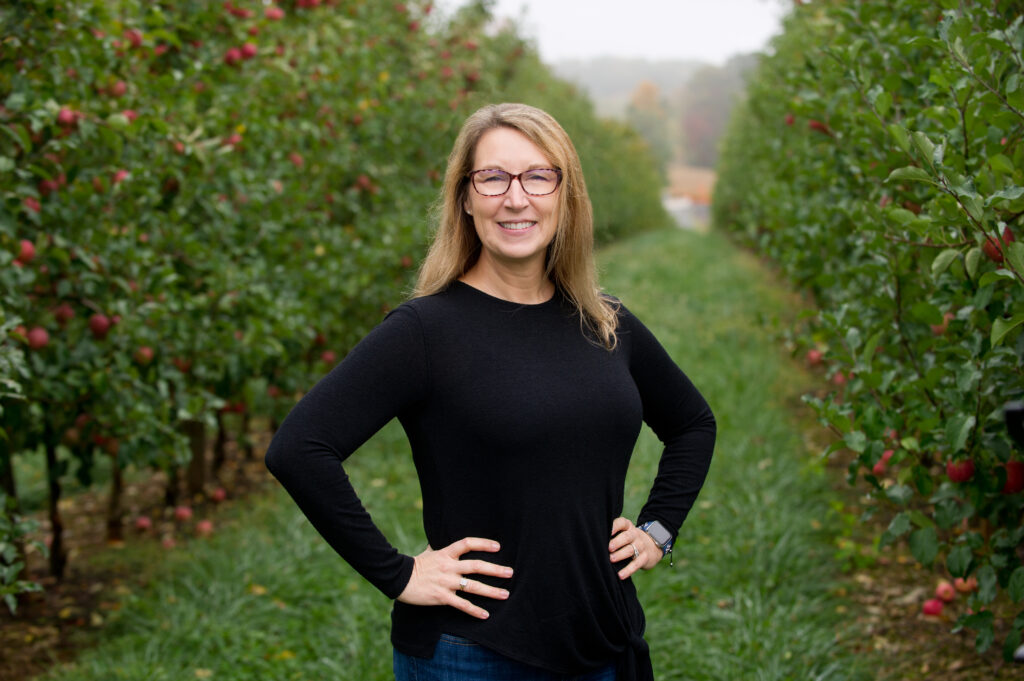
Throughout 2021, Trust In Food is inviting leaders of the Foundational Partners of America’s Conservation Ag Movement to share their vision for the future of conservation and sustainability in U.S. agriculture. In this post, we spotlight Amy O’Shea, President and CEO of Certis Biologicals, an ACAM partner.
Tell us a bit about yourself. How did you arrive in this leadership role within your organization, and how does a commitment to sustainability/conservation inform how you show up to work each day?
I joined the team February of 2020. Frankly speaking, I never could have imagined how crazy it was going to be, right on the cusp of realizing what the COVID pandemic would become.
I had been working, prior to joining Certis, for FMC for 23 years. In my roles there, I was in the ag industry, but I also had the opportunity to be in our health and nutrition market segment, as well as industrial chemicals and environmental solutions. We focused on developing products and solutions for soil and groundwater remediation, wastewater control and treatment. Throughout my past at FMC, my experience touched on food, ag and sustainability and I’ve tried to bring as much of that to Certis as I possibly can.
We believe that the portfolio that Certis brings to the market is truly sustainable in its nature, by utilizing naturally occurring organisms and molecules to solve growers crop protection challenges. How do we go a step beyond that? Getting that message out and increasing grower and consumer awareness is the key objective. We will continue to provide a pipeline of innovative products to growers and distributors. What’s next is how how Certis products can help our customers, growers and the industry meet their own sustainability goals and targets.
What’s one book you’ve read recently that’s challenging how you think about sustainability, conservation or the future of food and agriculture?
I mentioned that Certis is on its journey but I would also like to say I’m on my own personal journey. It’s really quite the beginning for me. While I felt a connection to sustainability being in the industry, I feel it’s incumbent upon me to educate myself. Most of what I’m doing is building my knowledge as opposed to being challenged by my own hard-thought beliefs.
Two books are on my Kindle and my Audible—we all do both these days. “Dirt to Soil” is a book by Gabe Brown. It was recommended to me a couple of years ago and details his family’s journey to regenerative agriculture. The book is about their journey to overcome their struggles and change how they were running the farm with regenerative agriculture techniques. How do you employ those techniques more universally as you think about food production worldwide?
The other one I’ve picked is “Rancher, Farmer, Fisherman” by Miriam Horn. I’m excited about that one.
That’s where I am: Let me learn, let me find out, let me understand better how this industry is evolving and what needs to happen. Then, let’s look back at Certis and figure out how we can contribute to that.
In a sentence, describe Certis Biologicals for executives in our audience who are unfamiliar with your work.
Certis Biologicals is a leading, global manufacturer and supplier of biological crop protection products and solutions for agriculture as well as the home and garden markets. We have a broad portfolio of solutions addressing a myriad of crop pests from insects and diseases. We can trace our legacy companies all the way back to the 1940s, but this year we are celebrating our 20th anniversary in the industry as Certis.
What is the biggest sustainability challenge your organization is facing, and how are you navigating possible ways to address and overcome that challenge?
I believe that our products are inherently sustainable as biological crop protection solutions. They have a minimal impact on the soil and can have a very positive impact on the environment. What we’re focused on is not just how do we ensure the innovation of new sustainable products, but how do we link ourselves to the sustainability challenges that our customers have? Many of the distributors, growers, large farms, family farm, food companies have evolving sustainability goals and targets. We believe our targets and solutions, and potentially the way we communicate and innovate, can help them achieve those sustainability goals.
The other thing is a little more simplistic and facing everybody: We, as an industry, are losing synthetics in the marketplace. It’s unfortunate because around the world, and in particular in Europe, there is so much regulatory pressure on the available synthetic solutions for crop protection. Now more than ever, our ability to provide a sustainable biological crop protection product—one that can complement synthetics and complement an Integrated Pest Management (IPM) program to take off some of that pressure—may enable us to keep some of those important tools in the toolbox. That’s also an opportunity for us to leverage our solutions and put that into practice.
We’re kicking off an initiative where we’re performing a life-cycle assessment of our products to quantify the net benefits of our solutions to the environment. We will then share that information with customers, partners and growers to potentially benefit their sustainability goals as well.
Can you share a bit about the recent rebrand of Certis Biologicals? Why this shift, and how is it reflective of your organization’s commitment to sustainable solutions for U.S. producers?
Our business has been very well known in certain market segments, and in particular in the U.S. and most definitely some key markets in Europe like France and Spain who are progressive with biologicals.
The brand Certis is grounded, but Certis USA didn’t necessarily represent the expansiveness of our current business. We sell in more than 50 countries around the world, and we are exclusively dedicated to biologicals. Biologicals as tools for growers in the U.S. and beyond have become so much more prevalent. You see the larger players coming into the market space not just for specialty crops but also for row crops.
We thought this was a opportune time in honor of our 20th anniversary to rebrand. We’re proud of being from the U.S., headquartered in the U.S., but we’re a global company. The new brand truly does represent what we bring to the table. Biologicals are in our DNA. It’s not just the products—but importantly, the people who’ve been here so long, they’ve really been in the forefront when biologicals started coming into the market in the early 1980s
As you reflect on Certis Biologicals’s 20 years in the marketplace, what lessons has your organization learned about what it takes to help U.S. producers succeed in their operations with novel products and technology?
When we think back to those early days of introduction of biologicals in crop protection, typically you were bringing them onto organic farms. There was a need: Organic growers didn’t have a lot of options. A territory manager or a product manager from Certis USA could show up and organic growers were open and willing and ready to try whatever was put in front of them.
Fast forward 20 years, and the exciting piece is you have an interest in biologicals that has expanded beyond just organic high-value fruit and vegetable growers to fruit and vegetable growers across the marketplace, and evolving even more robustly to high-acreage row-crops.
Across all of those transitions, what has remained a constant need, as well as what Certis has been very good at, is knowledge and information transfer to customers and growers. U.S. producers by their own nature—and I think producers around the world—they are innovative, open, willing to try new technologies, and we want to support them.
For sustainable solutions to be successful, we must be able to tell the story and transition that knowledge and information, not only what a product does but: What is that carry-on impact? What’s the impact on the environment? To soil? How does it work differently than synthetics? How can it work in combination with synthetics?
Just like one active ingredient in the same chemical family, strains of biologicals are different, as well. The ability to transition that knowledge and explain that knowledge in a way growers can make an informed decision with new alternatives and new tools remains one of the strongest capabilities and one which Certis has honed over the years. Even for us, that capability will need to continue to evolve as different tools come in.
Looking ahead, what trends in the biologicals space are most exciting to you? What potential do you see for this market segment, and what are the potential game-changing implications for U.S. agriculture’s sustainability outcomes – both for specialty crops and for row crops, where Certis Biologicals is increasingly looking to expand?
At the forefront of that is the fact people are interested in biologicals. I’m so excited that people are so excited about biologicals. The fact there’s a realization that these are tools that are important, regardless of your crop, and adoption rates are increasing, and there are biologicals that have proven efficacy, and that they can add value to a pest program. It just opens the door for different ways for growers to fight resistance and diversify their IPM programs, and protect the futures of their soils and watersheds.
What 3 sustainability/conservation trends have you most excited and optimistic about the future of U.S. agriculture and farming in the next 4 years?
Consumer food consumption is evolving, and it’s exciting of be a part of all of that: How are calories defined? How was that food produced? Where was it grown? How was it grown? What impact did the production of that food have on the environment? These are questions we are hearing more and more in from consumers.
Consumer awareness skyrocketed over the last five to six years. It’s exciting for those of us in agriculture. At FMC, we focused on inert ingredients and pharmaceuticals, and worked very closely with all major food companies to develop processed foods that make delivery of food shelf stable, improved mouth feel, all the gambits of it. Being on that side of the business and watching consumer preferences evolve and change, I knew I wasn’t too far away from consumers. The connectivity from consumer to grower is getting closer every day. The question of how food can be best grown is exciting and I think has direct impact on our products being a sustainable solution for growers. It helps for a homeowner to understand where that tomato comes from, how it was grown, and what it was treated with.
When we think about other areas that are important—and we’re still developing how we become involved in this—carbon sequestration is obviously a very important piece as stewards of the land in reduction of greenhouse gases. It’s hard to turn on the TV these days and not hear more and more about what that looks like.
Closer to home for us is ensuring that resistance management never goes away as an important element, including the use and incorporation of biologicals in IPM and the reduction of synthetic chemical runoff.
What’s one sustainability trend or issue keeps you up at night and gives you heartburn?
The shrinking toolbox for growers gives me heartburn, but it also gives me hope. It’s a double-edged sword. I grew up in agricultural chemicals. I’m still very loosely tied to synthetics and believe they are strong tools for our growers. I don’t believe the future is biologicals or chemistry, I believe its biologicals and chemistry working together.
My concern is the speed at which synthetics are being targeted to come off of the marketplace and the speed with which companies like Certis and others can bring alternative solutions to market. It’s not as if suddenly floodgates have opened and regulatory bodies are allowing rubber-stamped application of biologicals products. I’m not suggesting they should suddenly not require rigorous testing but synthetics are simply coming out faster than new biological products are coming in.
Another thing that gives me heartburn is that regulatory bodies around the world have spent years registering and protecting the environment from synthetic chemistries. Yet, the way in which you evaluate scientifically a biological product, whether microbial, a virus, etc., is and should be very different than how you regulate a synthetic product. But they end up being painted with a lot of the same broad strokes: environmental agencies, as an example, will ask for something that’s just not an appropriate test for a biological. How do regulatory entities around the world evolve to be able to appropriately register and monitor this influx of new types of technology?
Education and knowledge isn’t just directed at the grower. It needs to be directed to these governmental and regulatory bodies, as well. I don’t see a role for Certis alone as a crusader. Certis is part of organizations like America’s Conservation Ag Movement, CropLife America, Biological Products Industry Alliance. It takes all of those voices together on these regulatory committees, health and science committees, to be educating in that way. It takes a longer, coordinated effort, but a rising tide lifts all boats. Wholesale changes like this are much better for us to come together as an industry.
What’s the single most important action step that sustainable food and ag professionals should be taking in the next 12 months?
I think we all have to elevate our messaging and our education efforts and outreach, not only within our own industry but beyond the bounds of our industry, all the way to the consumer market. For those large food companies to hear about the efforts we’re making internally, we’ve got to elevate that message. It must be consistent across the board. It can’t just be “only biologicals” or “only synthetics.” It has to be a consistent message with communications and talking points: There are IPM solutions that are more beneficial to the environment. Here’s what we’re doing to promote the growth of different products.



